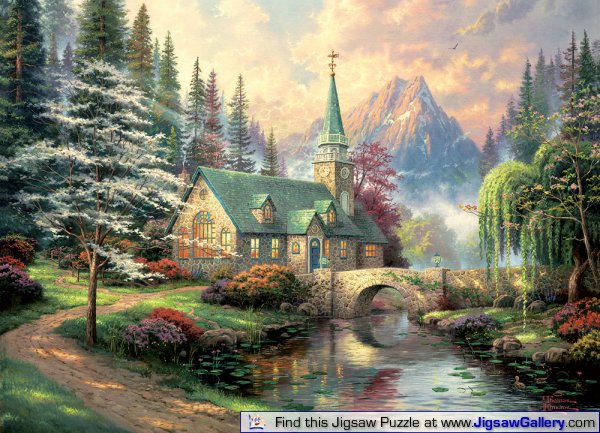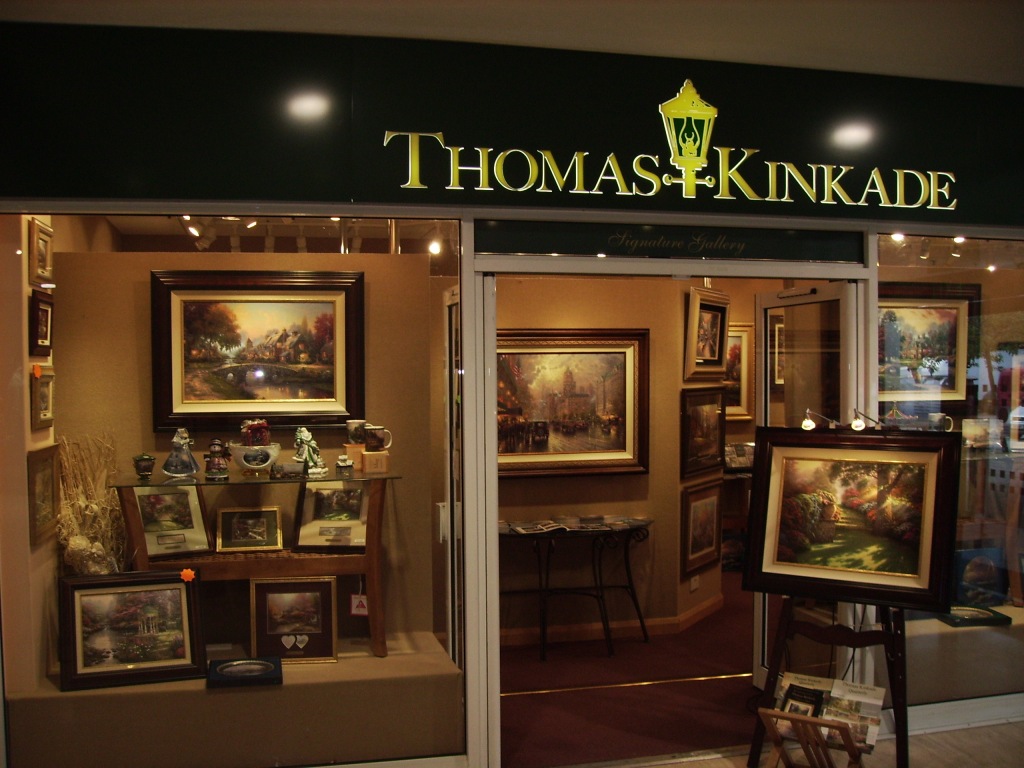You’ve seen his “Signature Galleries” in shopping malls. You’ve seen him on QVC or the Home Shopping Network, hucking his paintings at the masses. You’ve perhaps marveled at his shiny, naturalistic scenes of fire-lit cottages and bright, bubbly, Disney-esque landscapes. Or maybe you’ve looked at his cutesy, sparkly paintings and, like many art historians before you, said: “Ew.”
The quintessential Kinkadian image usually conjured up is relentlessly twee, with bulbous cottages, precious stone bridges, and gently winding roads and/or streams, all bathed in his signature glowing light. Even when Kinkade renders a more urban setting, his vision of an edenic world is a rigorously homogenous one, in which racial, ethnic and economic differences are suppressed. -Kjellman-Chapin
The Oxford English Dictionary describes kitsch as “Art or objets d’art characterized by worthless pretentiousness; to render worthless, to affect with sentimentality and vulgarity.” My biggest issue with Kinkade is that I see his work, not as fine art, but as kitsch. Not only kitsch, but kitsch being sold to the masses under the guise of fine art, when really it is nothing more than overpriced, mass production, based on a mash-up of techniques of canonical masters and emblazoned with Kinkade’s stamp of approval. There is no sense of personal expression or political or social relevance; it is “art” for money’s sake and nothing more.
My personal favorite of his series is his Disney Dreams Collection in which he paints similarly bubbly scenes involving Disney characters. On his website, Kinkade says about the following piece: “I believe Bambi’s First Year is the most breathtaking subject in my Disney Dreams Collection to date. I hope as you look at Bambi cresting the ridge of his domain, you too will feel empowered to live your best life and to count on a season of new beginnings, even when the challenges of life confront you. Truly for Bambi, and for us, life goes on.”
While I highly discourage boiling down all of Art History into a “top 15” list of artists, pieces, etc. due to the inherent loss of historical relevance and context, art historians must admit to the public’s desire for knowledge of the “who’s who” in art. Kinkade markets specifically to this audience, which is how he has gained his widespread commercial popularity. While Kinkade does not necessarily adhere to the canon’s laid out specific traits (e.g. innovation, precocity, originality, and unique authorial identity) in his “relentlessly twee” images, he creates a false sense of originality by drawing upon various artists and styles as if they were brand names, and then creating digital copies of his originals in order to mass produce them. He profits off of old masters’ canonical techniques and their success, much like a fake Louis Vuitton designer purse provides a guise of material wealth.
Further, since his works were not being acquired by public or private museum collections for sale or show, he then built his own museum (and galleries) dedicated to his work, so that visitors may align his name with others that they see in museums (e.g. Van Gogh, Monet, etc.). He has literally done everything in his power to market his way into the art historical canon. Regardless of whether or not you think that Thomas Kinkade is a great artist, you have to give it to the man…he is a fantastic businessman. The company that he co-owns with entrepreneur Ken Raasch, the Media Arts Group, raked in net sales of $120 million in 1999, and $140 million in 2000.
He has been billed as the foremost selling artist of all time, a powerhouse of self-promotion and retail savvy….[however], his aggressive marketing tactics have earned him a reputation as a huckster, which has served to derail any serious consideration of him as an artist. -Kjellman-Chapin
All of this talk about marketing, kitsch and the canon raises a very important question: do we construct our image of high art based on what we find in the most prestigious collections? Doesn’t that give these institutions an unprecedented power? I think so. A majority of the public could care less about how the art canon is formed and what pieces are being left out of it, and that is the audience most easily reached by artists like Kinkade. No historical relevance, no personal artistic expression, no political or social commentary….but hey, it’s cute, right?
Sources:
Thomas Kinkade’s website (Bambi’s First Year)
Monica Kjellman-Chapin, “Kinkade and the Canon: Art History’s (Ir)Relevance.” Partisan Canons, Anna Brzyski, ed. (Durham, Duke University Press, 2007): 267-288.





I dont do drugs, or drown my self in intoxicating substances. But Mr Kinkade, makes my heart smile. His pictures make me want to be inside those light glowing windows. They represent love.
Kinkade is clearly a successful businessman, so you aren’t alone in your sentiments!
I LOVE Thomas Kinkaides’ paintings. They represent an IDEAL more than anything else. I’m sure Mr. Kinkaide lived in the ‘real world’ and saw the t.v. news and what went on around him. THAT, I believe is WHY he created these scenes that I would LOVE to have in every room in my home. And while I can’t afford the paintings, themselves, I buy the calendars every Christmas. When the world gets to be a bit much, I lose myself inside a Thomas Kinkaide scene. A world without 9/11’s or people panhandling on downtown streets. (everyone had a job) . A world without the need for homeland security.
Sadly, there is a website( awfullywrong.com…or something idiotic like that) with the idealic scenes that are tragically altered with KKK creeps burning a cross on the front lawn of a residential home, or a fire behind a rustic cabin, or one scene with an alien space-ship and I NEED to ask the vandal or vandals…WHAT IS YOUR PROBLEM??? What do you have against scenes of serenity and quiet? I’m dying to know!
Yes! You said it! Love his paintings..
I dislike many things a lot more than a Kinkade painting.
Mostly sactimonious, envious, Kinkade haters.
Woah, woah, woah…fighting words! Sanctimonious? Hopefully not. Envious? Sure! Kinkade has found a crowd-pleasing type of art and he’s going to the bank with it. If you read what I wrote carefully, you’ll see that I applaud his business and marketing savvy numerous times! In terms of the actual works of art, however, I can’t look at a bubbly Bambi painting without wanting to vomit a little bit. Call it personal taste if you will, but it’s simply how I feel (not to mention that whole thing about Kinkade using the canon against his audience). If you dislike my point of view so fervently, perhaps you should give this a watch: http://www.thechristmascottagemovie.com/upgrade.html It may be a better use of your time than reading my little blog!
I think the art critics and historians are a bit pretentious for criticizing Kinkaide. His paintings are obviously beautiful. They may not be worth much because they’re mass produced, but there are a lot of things in life that are plentiful and still beautiful. It also doesn’t matter that he didn’t really invent the technique of painting, because few painters did. Many of these critics who dismiss Kinkaide love various piece of modern art trash because they believe it makes a “social comment.” If someone smashes a hole into the wall and calls it art, the critics say, “Ah, the ahtist is making a vonderful crtriticism of society.” But if a painter paints something that would look beautiful in your living room, well then that’s “kitsch.” Just appreciate the beautiful paintings.
“They may not be worth much because they’re mass produced, but there are a lot of things in life that are plentiful and still beautiful.” I love the way you stated this, and I certainly agree with you on this point.
I think that the main difference in opinions here lies in what we define as beautiful. Luckily, everyone finds beauty in different things, and that’s what makes the world go round. You can find beauty in Kinkade just as someone else can find beauty in modern art, which isn’t “trash” to everyone (just like Kinkade’s work isn’t “trash” to you.) Thank you for your response, it’s nice to hear people’s thought processes.
AMEN and AMEN! My sentiments exactly! Thank you. 😀
Those who can, do. Those who can’t, become art critics. Need I say more?
And if you can’t get other galleries to show your work, just build your own and put them in shopping malls.
@ jkcantwell
LOL!!! Well said, sistah!
Thomas’s painting are so beautiful and exquisite! Absolutely so very beautiful!
Thank you, Caz! 😀
I just read an article this morning about the top 8 university degrees that just aren’t worth the money. Guess what was at the top? Fine arts. So when an artist (if I dare use that word in conjunction with Mr. Kinkade) finds a way to paint a style he enjoys AND make money at it….really really good money…..it becomes written off as “kitsch”… hmmmmm…..interesting.
Whether or not one enjoys his style is immaterial. The snobbery of the art world is nauseating. So go vomit over your print of Bambi by Kinkade. I won’t be hanging it on my wall either, I have a different taste in art. But neither will I write someone off who worked hard and did well doing what HE LOVED! I appreciate the artist (there! I said it!), Thomas Kinkade, for his contribution to our culture through his love of beauty as he saw it as Van Gogh and his vision of angst, or Monet and his garden. Of the three, I most prefer Monet, and I don’t care at all for Van Gogh’s style. Who knows….maybe Van Gogh painted kitsch too and we just didn’t realize it……
LOL
HELP! I’m CONFUSED!!!! WHAT IS WRONG WITH THOMAS KINKAIDE’S PAINTING????
I work in an office. In said office, there are at least THREE paintings that look more like an explosion in a paint factory or a pre-schooler’s temper tantrum on canvass. Random color, all over the place. No order. No sense of anything. Just…. random paint. I can do that! But I couldn’t begin to hope to do what Mr. Kinkaide accomplished. Thomas Kinkaide painted scenes of …idealism. HOPE. Something he wanted to remember from another time, or a time he’d wished still existed. WHY is that a problem for some people??? If I could paint like Thomas Kinkaide, I’d paint a NYC landscape WITH the WTC in the background.
There is enough crap in the world, WHY are people so intent on destroying what little hope people do want to share?
Its time for artists to stop starving….I was a commercial artist for many years-it was a job. Other people viewed me as an artist, got way more of my share of, “wow, you are so talented”…try and cash that at the bank! If I were to do it over again, I would spend more time learning to market like Kinkade. He took a cutsy idea and made a living. More artist would like to do that I’m sure. Art is about expression….and wouldn’t it be nice if artists could make a living without having to spend their talent designing commercials!!!
Wow! I’m so happy to see comments here that express exactly how i feel… I couldn’t say it better … Thomas Kincaid painted what he loved and made money at it AND opened his own museum when he couldn’t get in another one… What exactly is wrong with that..??We should all be so proactive making our dreams come true… deb